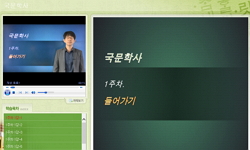본 연구에서는 근대 시기 일본인을 위한 한국어 학습서에 나타나는 한국어 문법과 일본어 문법간의 영향 관계를 고찰하는 한편 어문정책에 따른 언문철자법의 기술 양상을 살펴보기 위해 ...
http://chineseinput.net/에서 pinyin(병음)방식으로 중국어를 변환할 수 있습니다.
변환된 중국어를 복사하여 사용하시면 됩니다.
- 中文 을 입력하시려면 zhongwen을 입력하시고 space를누르시면됩니다.
- 北京 을 입력하시려면 beijing을 입력하시고 space를 누르시면 됩니다.
https://www.riss.kr/link?id=A108187242
- 저자
- 발행기관
- 학술지명
- 권호사항
-
발행연도
2022
-
작성언어
-
- 주제어
-
등재정보
KCI등재
-
자료형태
학술저널
-
수록면
315-358(44쪽)
- 제공처
-
0
상세조회 -
0
다운로드
부가정보
국문 초록 (Abstract)
본 연구에서는 근대 시기 일본인을 위한 한국어 학습서에 나타나는 한국어 문법과 일본어 문법간의 영향 관계를 고찰하는 한편 어문정책에 따른 언문철자법의 기술 양상을 살펴보기 위해 노기주(魯璣柱)가 저술한 『應用自在朝鮮語法詳解』(1924)의 문법 기술 양상을 고찰하였다. 먼저 저자의 생애와 이력을 살펴 이 책이 간행된 계기를 고찰하였고 음운 및 발음의 기술 양상과 품사 항목 설정, 교육 내용의 구성을 살펴보았다. 저자 노기주는 경찰관강습소 교관으로 근무한 경험을 살려 경찰관의 한국어 강습 및 한국어 시험 대비 목적으로 이 책을 저술하였다. 또한 이 책은 음운 및 품사 분류 등의 문법 내용을 체계적으로 수록하여 문법 설명에 충실한 학습서라는 점이 특징적이다. 음운 및 발음의 기술에서는 조선총독부에서 1921년 3월에 개정, 공포한 「보통학교용 언문철자법대요」를 반영하였으며 영어 알파벳으로 발음을 표기하였음을 알 수 있었다. 또한 토(吐), 수사 등의 품사 설정에서 한국인 문법가의 문법 체계에 영향을 받은 것을 알 수 있었으며 조동사의 설정은 일본어 문법의 영향을 받은 것으로 보인다. 한편 한자의 천자음과 단어집을 수록하였으며 화문선역(和文鮮譯)의 주의 사항을 제시하여 조동사 및 토(吐)의 용법을 주의하도록 하고 있는데 이는 조선어장려시험에 대비하기 위한 학습 내용 구성으로 여겨진다. 조선어장려시험의 화문선역(和文鮮譯)의 문항은 문어체로, 국어선역(和語鮮譯)의 문항은 구어체로 답안을 작성해야 하는데 노기주(魯璣柱)의 『應用自在朝鮮語法詳解』(1924)에서는 이러한 한국어의 문어체와 구어체를 모두 학습할 수 있도록 학습 내용을 구성한 것을 알 수 있었다.
다국어 초록 (Multilingual Abstract)
This article examines the descriptional aspects of phonology and grammar of Noh Ki-ju’s 『應用自在朝鮮語法詳解』(1924), a Korean language study book for Japanese during the modern period. The author Noh Ki-ju worked as a police officer...
This article examines the descriptional aspects of phonology and grammar of Noh Ki-ju’s 『應用自在朝鮮語法詳解』(1924), a Korean language study book for Japanese during the modern period. The author Noh Ki-ju worked as a police officer’s instructor, and since this book was published around the time of the < Joseon Language Encouragement Regulations > and < Joseon Language Tests >, this book examined the composition of Korean language classes and Korean language tests for police officers at that time. Meanwhile, in March 1921, the Chosun Governor-General revised and promulgated < Ordinary school Spelling system >, and a large number of learning books reflecting this in the learning contents were published. While many Korean language books around this time were written for various learning purposes for beginners, this book is characterized by setting public officials of a certain status as learners and for special educational purposes of preparing for the Korean language test. In addition, Noh Ki-ju’s 『應用自在朝鮮語法詳解』(1924) is characterized by being faithful to grammar explanations by systematically recording grammar contents. In addition, unlike other Korean language books written for police officers, it seems that the grammar system of Korean grammarians was introduced in the composition of grammar contents to describe the classification and content of parts. In terms of phonology and pronunciation, the < Ordinary school Spelling system Summary > revised and promulgated by the Governor-General of Joseon in March 1921 was reflected, and the pronunciation was written in English alphabets. In addition, it was influenced by Korean grammarians in the setting of parts such as ‘postposition’ and ‘numeral’, and the setting of ‘auxiliary verb’ seems to have been influenced by Japanese grammar. On the other hand, a collection of Chinese characters and a vocabulary book, and precautions for <和文鮮譯> are presented to pay attention to the use of ‘auxiliary verbs’ and ‘postposition’, which is in preparation for the < Joseon Language Recommend Test >. The questions of <和文鮮譯> should be written in written form, and the questions of <和語鮮譯> should be written in spoken form, Noh Ki-joo’s 『應用自在朝鮮語法詳解』(1924) found that the learning contents were composed so that both the written and spoken Korean could be learned.
동일학술지(권/호) 다른 논문
-
복합어에서의 유기음화 현상 연구 - 제주방언을 중심으로 -
- 영주어문학회
- 권미소 ( Kwon Mi-so )
- 2022
- KCI등재
-
수도권 거주 화자의 자음군 말음 어간 실현 양상에 대하여
- 영주어문학회
- 김수영 ( Kim Sooyoung )
- 2022
- KCI등재
-
19세기 말 20세기 초 밀양 방언 모음의 음운론적 특징
- 영주어문학회
- 이래호 ( Lee Raeho )
- 2022
- KCI등재
-
활용형의 모음조화 양상과 변이 - 메신저 말뭉치를 중심으로 -
- 영주어문학회
- 하영우 ( Ha Young-woo )
- 2022
- KCI등재





 KISS
KISS


